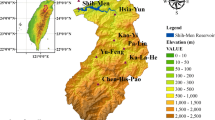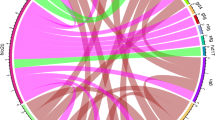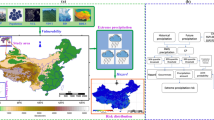Abstract
In response to the impacts of extreme precipitation on human or natural systems under climate change, the development of climate risk assessment approach is a crucial task. In this paper, a novel risk assessing approach based on a climate risk assessment framework with copula-based approaches is proposed. Firstly, extreme precipitation indices (EPIs) and their marginal distributions are estimated for historical and future periods. Next, the joint probability distributions of extreme precipitation are constructed by copula methods and tested by goodness-of-fit indices. The future joint probabilities and joint return periods (JRPs) of the EPIs are then evaluated. Finally, change rates of JRPs for future periods are estimated to assess climate risk with the quantitative data of exposure and vulnerability of a protected target. An actual application in Taiwan Island is successfully conducted for climate risk assessment with the impacts of extreme precipitation. The results indicate that most of regions in Taiwan Island might have higher potential climate risk under different scenarios in the future. The future joint probabilities of precipitation extremes might cause the high risk of landslide and flood disasters in the mountainous area, and of inundation in the plain area. In sum, the proposed climate risk assessing approach is expected to be useful for assisting decision makers to draft adaptation strategies and face high risk of the possible occurrence of natural disasters.










Similar content being viewed by others
References
Allen SK, Ballesteros-Canovas J, Randhawa SS, Singha AK, Huggel C, Stoffel M (2018) Translating the concept of climate risk into an assessment framework to inform adaptation planning: insights from a pilot study of flood risk in Himachal Pradesh, Northern India. Environ Sci Pol 87:1–10
Chen CW, Saito H, Oguchi T (2015) Rainfall intensity–duration conditions for mass movements in Taiwan. Progress in Earth and Planetary Science 2:14. UNSP
de Melo Mendes BV, de Souza RM (2004) Measuring financial risks with copulas. Int Rev Financ Anal 13(1):27–45
Fan YR, Huang WW, Huang GH, Huang K, Li YP, Kong XM (2016) Bivariate hydrologic risk analysis based on a coupled entropy-copula method for the Xiangxi River in the three gorges reservoir area, China. Theor Appl Climatol 125(1-2):381–397
Goswami UP, Hazra B, Goyal MK (2018) Copula-based probabilistic characterization of precipitation extremes over North Sikkim Himalaya. Atmos Res 212:273–284
Haines A, Kovats RS, Campbell-Lendrum D, Corvalán C (2006) Climate change and human health: impacts, vulnerability and public health. Public Health 120(7):585–596
IPCC (2001) Climate change 2001: impacts, adaptation, and vulnerability. Contribution of working group II to the third assessment report of the intergovernmental panel on climate change. Cambridge University Press, Cambridge
IPCC (2007) Climate change 2007: impacts, adaptation, and vulnerability. Working group II contribution to the intergovernmental panel on climate change fourth assessment report. Summary for policy makers. IPCC, Geneva
IPCC (2014) Climate change 2014: impacts, adaptation, and vulnerability. Part a: global and sectoral aspects. Contribution of working group II to the fifth assessment report of the intergovernmental panel on climate change. Cambridge University Press, Cambridge
Jeong DI, Sushama L, Khaliq MN, Roy R (2014) A copula-based multivariate analysis of Canadian RCM projected changes to flood characteristics for northeastern Canada. Clim Dyn 42(7-8):2045–2066
Jhong BC, Tung CP (2018) Evaluating Future Joint Probability of Precipitation Extremes with a Copula-Based Assessing Approach in Climate Change. Water Resour Manag 32(13):4253–4274
Jhong BC, Wang JH, Lin GF (2017) An integrated two-stage support vector machine approach to forecast inundation maps during typhoons. J Hydrol 547:236–252
Karl TR, Nicholls N, Ghazi A (1999) CLIVAR/GCOS/WMO workshop on indices and indicators for climate extremes: workshop summary. Clim Chang 42:3–7
Kunkel KE, Pielke RA, Changnon SA (1999) Temporal fluctuations in weather and climate extremes that cause economic and human health impacts: a review. Bull Am Meteorol Soc 80(6):1077–1098
Li J, Zhang Q, Chen YD, Singh VP (2015) Future joint probability behaviors of precipitation extremes across China: spatiotemporal patterns and implications for flood and drought hazards. Glob Planet Chang 124:107–122
Lin GF, Jhong BC (2015) A real-time forecasting model for the spatial distribution of typhoon rainfall. J Hydrol 521:302–313
Lin CY, Tung CP (2017) Procedure for selecting GCM datasets for climate risk assessment. Terr Atmos Ocean Sci 28(1):43–55
Liu TM, Tung CP, Ke KY, Chuang LH, Lin CY (2009) Application and development of a decision-support system for assessing water shortage and allocation with climate change. Paddy Water Environ 7:301–311
Liu J, Hertel TW, Diffenbaugh NS, Delgado MS, Ashfaq M (2015) Future property damage from flooding: sensitivities to economy and climate change. Clim Chang 132(4):741–749
Madadgar S, AghaKouchak A, Farahmand A, Davis SJ (2017) Probabilistic estimates of drought impacts on agricultural production. Geophys Res Lett 44(15):7799–7807
Mann ME, Rahmstorf S, Kornhuber K, Steinman BA, Miller SK, Coumou D (2017) Influence of anthropogenic climate change on planetary wave resonance and extreme weather events. Sci Rep 7:45242
McMichael AJ, Woodruff RE, Hales S (2006) Climate change and human health: present and future risks. Lancet 367(9513):11–17
Nandintsetseg B, Greene JS, Goulden CE (2007) Trends in extreme daily precipitation and temperature near Lake Hovsgol, Mongolia. Int J Climatol 27(3):341–347
Nelsen RB (2006) Introduction to copulas. Lecture notes statistics. Springer-Verlag, New York
Peduzzi P, Dao H, Herold C, Mouton F (2009) Assessing global exposure and vulnerability towards natural hazards: the disaster risk index. Nat Hazards Earth Syst Sci 9:1149–1159
Peterson TC (2005) Climate change indices. WMO Bull 54(2):83–86
Petley D (2012) Global patterns of loss of life from landslides. Geology 40(10):927–930
Qian L, Wang H, Dang S, Wang C, Jiao Z, Zhao Y (2018) Modelling bivariate extreme precipitation distribution for data-scarce regions using Gumbel–Hougaard copula with maximum entropy estimation. Hydrol Process 32(2):212–227
Rana A, Moradkhani H, Qin Y (2017) Understanding the joint behavior of temperature and precipitation for climate change impact studies. Theor Appl Climatol 129(1–2):321–339
Richardson CW, Wright DA (1984) WGEN: a model for generating daily weather variables. United States Department of Agriculture, Agricultural Research Service, Washington, DC
Ronco P, Zennaro F, Torresan S, Critto A, Santini M, Trabucco A et al (2017) A risk assessment framework for irrigated agriculture under climate change. Adv Water Resour 110:562–578
Ruiter MCD, Ward PJ, Daniell JE, Aerts JCJH (2017) Review article: a comparison of flood and earthquake vulnerability assessment indicators. Nat Hazards Earth Syst Sci 17(7):1231–1251
Salvadori G, De Michele C (2004) Frequency analysis via copulas: theoretical aspects and applications to hydrological events. Water Resour Res 40(12):W12511
Shieh SL (2000) User's guide for typhoon forecasting in the Taiwan area (VIII). Central Weather Bureau, Taipei
Sillmann J, Roeckner E (2008) Indices for extreme events in projections of anthropogenic climate change. Clim Chang 86(1–2):83–104
Sisco MR, Bosetti V, Weber EU (2017) When do extreme weather events generate attention to climate change? Clim Chang 143(1–2):227–241
Smith BA, Ruthman T, Sparling E, Auld H, Comer N, Young I, Lammerding AM, Fazil A (2015) A risk modeling framework to evaluate the impacts of climate change and adaptation on food and water safety. Food Res Int 68:78–85
Su FC, Mukherjee B, Batterman S (2014) Modeling and analysis of personal exposures to VOC mixtures using copulas. Environ Int 63:236–245
Sun DY, Zhang DW, Cheng XT (2012) Framework of national non-structural measures for flash flood disaster prevention in China. Water 4(1):272–282
Taylor KE, Stouffer RJ, Meehl GA (2012) An overview of CMIP5 and the experiment design. Bull Am Meteorol Soc 93(4):485–498
Terzi S, Torresan S, Schneiderbauer S, Critto A, Zebisch M, Marcomini A (2019) Multi-risk assessment in mountain regions: a review of modelling approaches for climate change adaptation. J Environ Manag 232:759–771
Tung CP, Liu TM, Chen SW, Ke KY, Li MH (2014) Carrying capacity and sustainability appraisals on regional water supply systems under climate change. British Journal of Environment and Climate Change 4:27–44
Tung CP, Tsao JH, Tien YC, Lin CY, Jhong BC (2019) Development of a novel climate adaptation algorithm for climate risk assessment. Water 11(3):497
UNFCCC (2004) Application of methods and tools for assessing impacts and vulnerability, and developing adaptation responses. Background paper by the UNFCCC Secretariat. FCCC/SBSTA/2004/INF.13. UNFCCC, Bonn
van Vuuren DP, Stehfest E, den Elzen MGJ, Kram T, van Vliet J, Deetman S, Isaac M, Goldewijk SK, Holf A, Beltran AM, Oostenrijk R, van Ruijven B (2011) RCP2.6: exploring the possibility to keep global mean temperature increase below 2 °C. Clim Chang 109:95–116
Volpi E, Fiori A (2014) Hydraulic structures subject to bivariate hydrological loads: return period, design, and risk assessment. Water Resour Res 50(2):885–897
Voss R, May W, Roeckner E (2002) Enhanced resolution modelling study on anthropogenic climate change: changes in extremes of the hydrological cycle. Int J Climatol 22(7):755–777
Wahl T, Mudersbach C, Jensen J (2012) Assessing the hydrodynamic boundary conditions for risk analyses in coastal areas: a multivariate statistical approach based on copula functions. Nat Hazards Earth Syst Sci 12(2):495–510
Wahl T, Jain S, Bender J, Meyers SD, Luther ME (2015) Increasing risk of compound flooding from storm surge and rainfall for major US cities. Nat Clim Chang 5(12):1093
Weaver CP, Moss RH, Ebi KL, Gleick PH, Stern PC, Tebaldi C et al (2017) Reframing climate change assessments around risk: recommendations for the US National Climate Assessment. Environ Res Lett 12(8):080201
Wu CC, Kuo YH (1999) Typhoons affecting Taiwan: current understanding and future challenges. Bull Am Meteorol Soc 80:67–80
Zhang DD, Yan DH, Lu F, Wang YC, Feng J (2015) Copula-based risk assessment of drought in Yunnan province, China. Nat Hazards 75(3):2199–2220
Acknowledgements
The authors are grateful to the Taiwan Climate Change Projection and Information Platform Project (TCCIP) funded by Ministry of Science and Technology (MOST) providing the projections of general circulation models with the climate scenarios and revised by the method of bias correction and spatial disaggregation. The authors would also like to appreciate all colleagues and students from Sustainable Development Laboratory (SDLab) in the Department of Bioenvironmental Systems Engineering, who contributed to this study.
Author information
Authors and Affiliations
Corresponding author
Ethics declarations
Conflict of Interest
None.
Additional information
Publisher’s Note
Springer Nature remains neutral with regard to jurisdictional claims in published maps and institutional affiliations.
Electronic supplementary material
ESM 1
(DOCX 285 kb)
Rights and permissions
About this article
Cite this article
Jhong, BC., Huang, J. & Tung, CP. Spatial Assessment of Climate Risk for Investigating Climate Adaptation Strategies by Evaluating Spatial-Temporal Variability of Extreme Precipitation. Water Resour Manage 33, 3377–3400 (2019). https://doi.org/10.1007/s11269-019-02306-8
Received:
Accepted:
Published:
Issue Date:
DOI: https://doi.org/10.1007/s11269-019-02306-8




